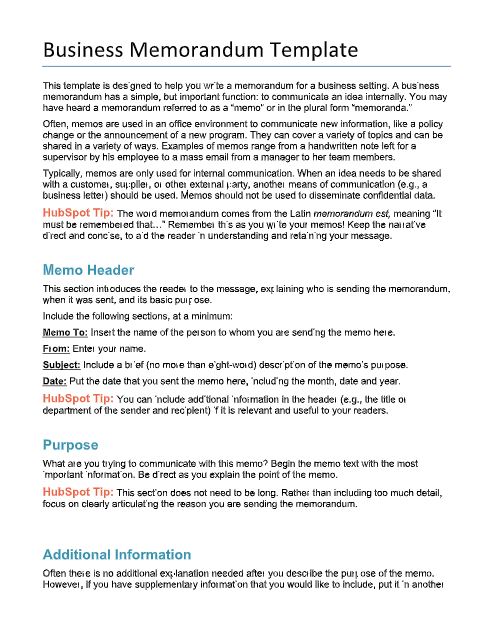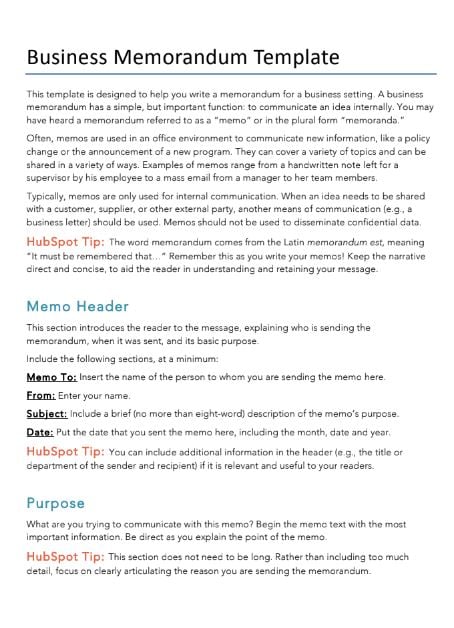Business Memorandum Template
This template is designed to help you write a memorandum for a business setting. A business memorandum has a simple, but important function: to communicate an idea internally. You may have heard a memorandum referred to as a “memo” or in the plural form “memoranda.”
Often, memos are used in an office environment to communicate new information, like a policy change or the announcement of a new program. They can cover a variety of topics and can be shared in a variety of ways. Examples of memos range from a handwritten note left for a supervisor by his employee to a mass email from a manager to her team members.
Typically, memos are only used for internal communication. When an idea needs to be shared with a customer, supplier, or other external party, another means of communication (e.g., a business letter) should be used. Memos should not be used to disseminate confidential data.
HubSpot Tip: The word memorandum comes from the Latin memorandum est, meaning “It must be remembered that…” Remember this as you write your memos! Keep the narrative direct and concise, to aid the reader in understanding and retaining your message.
Memo Header
This section introduces the reader to the message, explaining who is sending the memorandum, when it was sent, and its basic purpose.
Include the following sections, at a minimum:
Memo To: Insert the name of the person to whom you are sending the memo here.
From: Enter your name.
Subject: Include a brief (no more than eight-word) description of the memo’s purpose.
Date: Put the date that you sent the memo here, including the month, date and year.
HubSpot Tip: You can include additional information in the header (e.g., the title or department of the sender and recipient) if it is relevant and useful to your readers.
Purpose
What are you trying to communicate with this memo? Begin the memo text with the most important information. Be direct as you explain the point of the memo.
HubSpot Tip: This section does not need to be long. Rather than including too much detail, focus on clearly articulating the reason you are sending the memorandum.
Additional Information
Often there is no additional explanation needed after you describe the purpose of the memo. However, if you have supplementary information that you would like to include, put it in another section. This keeps the purpose of the memo clear and allows busy workers to understand and act on your memo efficiently.
HubSpot Tip: Though they are brief, memos are typically written with a friendly and casual tone. Save the intricate details and technical language for formal documents.
Action Requested
A memo might include a request for an action to be carried out by the recipient. For example, the Human Resources department might announce a new policy to the managers at the company and ask them to relay the information to their staff. This section defines the parameters of the requested action.
Action Requested: Include a one-sentence description of the requested action (e.g., share new policy with your staff).
Person(s) Assigned: List the people or teams who need to complete the action (e.g., all Department Managers).
Deadline: Designate a date and time by which the action should be completed (e.g., 5:00 p.m. on November 18, 2020).
HubSpot Tip: Be sure to set a reasonable deadline that will not place too much of a burden on the assigned resource.

